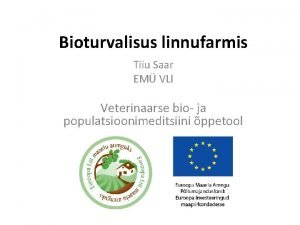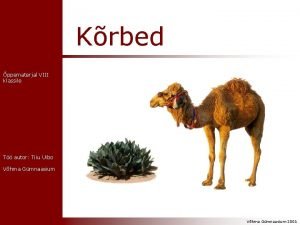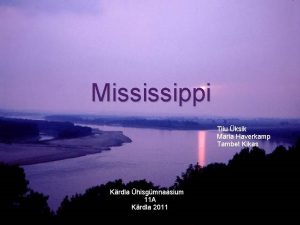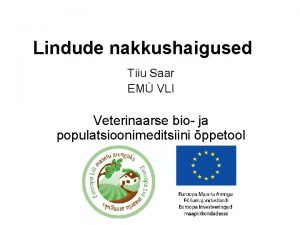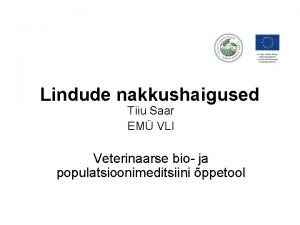Our Natural World 2013 Free Tiiu Pix com


























- Slides: 26

Our Natural World © 2013 Free. Tiiu. Pix. com MONARCH BUTTERFLY THE MONARCH BUTTERFLY This slide show courtesy of Free. Tiiu. Pix. com Free educational resources photographed & written by Tiiu Roiser BAA, BEd. & Kevin Chorowiec OCT, BAS, BEd. © 2013 Free. Tiiu. Pix. com

Our Natural World © 2013 Free. Tiiu. Pix. com MONARCH BUTTERFLY Note: Monarch butterflies live in North America, Bermuda, Hawaii, the Solomons, New Caledonia, New Zealand, Australia, new Guinea, Ceylon, India, the Azores and the Canary Islands. It rarely strays to western Europe. The migrations differ depending upon where the butterflies live. These facts are based on Monarchs living in North America – specifically, Ontario.

Our Natural World © 2013 Free. Tiiu. Pix. com MONARCH BUTTERFLY Some consider the Monarch butterfly to be the most beautiful and “king” of the butterflies. Perhaps that’s how the name “Monarch”, meaning king, came to be? This is not a Free. Tiiu. Pix image. This Monarch butterfly image is licensed under a Creative Commons License courtesy of Eli Snyder at www. freenaturepictures. com

Our Natural World MONARCH BUTTERFLY © 2013 Free. Tiiu. Pix. com Monarch butterflies go through four stages during one life cycle. They have four generations in one year. Egg Monarch Butterfly Worm-like larva (Caterpillar) Pupa (Chrysalis) This cycle occurs four times each year. The final, 4 th, generation is the one that migrates and begins the four cycles again next spring.

Our Natural World © 2013 Free. Tiiu. Pix. com MONARCH BUTTERFLY In March and April, creamy-white eggs with small ridges are laid on undersides of the leaves of Milkweed plants.

Our Natural World MONARCH BUTTERFLY © 2013 Free. Tiiu. Pix. com The eggs are hard to spot, they are VERY tiny.

Our Natural World © 2013 Free. Tiiu. Pix. com MONARCH BUTTERFLY Only 2 -5 caterpillars will hatch from the hundreds that a female Monarch lays. Some die naturally; Predators may eat it; Parasites lay eggs on it; Bacterial & viral infections may kill it.

Our Natural World © 2013 Free. Tiiu. Pix. com MONARCH BUTTERFLY In about 3 -5 days, the eggs will hatch into baby caterpillars also known as “Larvae”. The new caterpillar is only about 0. 1 inches long and weighs about 0. 55 grams.

Our Natural World MONARCH BUTTERFLY © 2013 Free. Tiiu. Pix. com Tentacles T h o r a x A b d o m e n Head True Legs A Monarch larva or caterpillar has… Tentacles; Head; Thorax; Abdomen; Prolegs Nine brown rings on abdomen; Three pairs of “true legs” with claws attached; and Five pairs of prolegs that extend backwards.

Our Natural World © 2013 Free. Tiiu. Pix. com MONARCH BUTTERFLY The larvae first eat their own eggshell and then immediately begin to munch on the Milkweed plant and grow.

Our Natural World © 2013 Free. Tiiu. Pix. com MONARCH BUTTERFLY It doesn’t matter which of the many types of Milkweed plants the eggs have been laid on, but Milkweed is the ONLY thing the larvae will eat. Common Milkweed Swamp Milkweed Photographed in Northern Ontario Photographed in upstate New York

Our Natural World © 2013 Free. Tiiu. Pix. com MONARCH BUTTERFLY Common Milkweed Because they only eat Milkweed, Monarchs are sometimes called the “Milkweed butterfly”.

Our Natural World MONARCH BUTTERFLY © 2013 Free. Tiiu. Pix. com The little caterpillar eats and poops….

Our Natural World MONARCH BUTTERFLY © 2013 Free. Tiiu. Pix. com and eats and poops….

Our Natural World MONARCH BUTTERFLY © 2013 Free. Tiiu. Pix. com and eats and poops…. for about two weeks.

Our Natural World © 2013 Free. Tiiu. Pix. com MONARCH BUTTERFLY At the end of the larva stage, the caterpillar has grown to be about 2 inches long.

Our Natural World © 2013 Free. Tiiu. Pix. com MONARCH BUTTERFLY The caterpillar now begins looking for a place to attach itself to start the process of “metamorphosis”. It attaches itself upside down to a stem or leaf, and transforms into a green, “pupa” or “chrysalis”.

Our Natural World © 2013 Free. Tiiu. Pix. com MONARCH BUTTERFLY The ten days that the caterpillar spends inside the chrysalis is a time of rapid change. The caterpillar’s body parts are changing from that of a crawling caterpillar to that of a beautiful butterfly capable of flight. The chrysalis becomes clear as the butterfly is ready to emerge. Clip art © Tiiu Roiser

Our Natural World © 2013 Free. Tiiu. Pix. com MONARCH BUTTERFLY The Monarch butterfly emerges from the chrysalis, dries its wings and flies away to enjoy its short 2 -6 week life. During this time, it can feed on any flower.

Our Natural World MONARCH BUTTERFLY © 2013 Free. Tiiu. Pix. com Proboscis A Monarch uses a “proboscis” to suck up its liquid food. The proboscis is like a straw which is usually coiled under the head of the butterfly. Adults enjoy feeding on nectar, water and liquids from fruits like banana, oranges and watermelon.

Our Natural World MONARCH BUTTERFLY © 2013 Free. Tiiu. Pix. com The first generation of Monarch butterflies will lay her eggs for generation number two, and then she dies. This cycle continues until the 4 th generation. Monarch Butterfly Generation Cycles 1 st Generation – lays eggs in March/April 2 nd Generation – Butterflies emerge May/June 3 rd Generation – Butterflies emerge July/August 4 th Generation – Emerge in Sept/Oct. The fourth generation of Monarch butterflies is born to fly and do not die after 2 -6 weeks. Instead, this generation migrates to a warmer climate like Mexico or California.

Our Natural World © 2013 Free. Tiiu. Pix. com MONARCH BUTTERFLY The Monarch butterflies will live in the south for 2 -8 months until it’s time to fly back to the Milkweed plants and start the process all over again. On their way north, most Monarchs lay their eggs on fresh milkweed somewhere between Mexico and Canada. A few, do return all the way to Ontario (in May) to lay their eggs. The butterfly photograph is not a Free. Tiiu. Pix image. This Monarch butterfly image is adapted from an image licensed under a Creative Commons License courtesy of Eli Snyder at www. freenaturepictures. com

Our Natural World © 2013 Free. Tiiu. Pix. com Discussion topics…. How do the new generations of Monarchs know where to migrate? How do they know to come to the very same Eucalyptus trees that there ancestors came to? Where will the Monarchs hibernate when all the trees are cut down for roads, houses and farms? Monarch butterflies are decreasing because Milkweed plants are being cut down to make way for population growth. What will happen to the Monarch? MONARCH BUTTERFLY

Our Natural World MONARCH BUTTERFLY © 2013 Free. Tiiu. Pix. com Fun Monarch Facts Monarchs are the only insects that migrate to a warmer climate that is up to 3, 000 miles (4, 828 kilometers) each way! Monarch butterflies are poisonous! While they won’t harm a human, the chemicals (cardiac glycosides) that they eat as larvae from the Milkweed plant builds up inside of them. This gives Monarchs a poisonous defence against predators. A Monarch’s bright colours warn predators that they taste bad and are poisonous. Butterflies have the broadest visual spectrum of any known animal and can see more colours than humans. They can see UV light.

Our Natural World MONARCH BUTTERFLY © 2013 Free. Tiiu. Pix. com Fun Monarch Facts Monarchs flap their wings about 5 to 12 times per second. That’s 300 to 720 times a minute. Compared to other butterflies, this is actually quite slow! Monarchs fly efficiently and take advantage of air currents and soar using the wind. They don’t fly in the rain. One tagged Monarch flew 265 miles in one day! Monarchs breathe through tiny openings on the sides of their bodies called “spiracles”. The holes open into a system of tubes in their body called “trachea” that carry oxygen all over their bodies. Monarchs don’t have lungs! Monarchs can’t shut their eyes because they don’t have eyelids! Only male Monarchs have a black spot called the “androconium” on each of his hind wings. Artwork courtesy of © Philip Martin

Our Natural World MONARCH BUTTERFLY © 2013 Free. Tiiu. Pix. com This slide show courtesy of Free. Tiiu. Pix. com Free educational resources photographed & written by Tiiu Roiser BAA, BEd. & Kevin Chorowiec OCT, BAS, BEd. This presentation may only be used in a non-commercial manner and setting. It may be used for personal and educational purposes provided that: 1. Only one copy of the Presentation is downloaded to your computer; 2. The Presentation may NOT be uploaded to your personal website, classroom website, nor school website; 3. The Presentation may NOT be posted or shared on a presentation sharing site such as Slide. Share or similar website; 4. The Presentation may NOT be shared or posted on a network; 5. Use of any Images or text within the Presentation is subject to the Terms of Use found on www. Free. Tiiu. Pix. com 6. You may NOT remix the content, delete/add slides nor remove the copyright or other proprietary notices and source citations embedded in or attached to this content. Visit www. Free. Tiiu. Pix. com for Terms of Use & FAQ including more free slideshow presentations and high resolution images. http: //www. monarch-butterfly. com/ A highly recommended source for much material. http: //animals. nationalgeographic. com/animals/bugs/monarch-butterfly/ http: //www. pc. gc. ca/eng/pn-np/on/pelee/natcul 5. aspx http: //www. learner. org/jnorth/search/Monarch. Notes 1. html#6 http: //www. freenaturepictures. com/monarch-butterfly-pictures. php http: //www. pc. gc. ca/eng/pn-np/on/pelee/natcul 5. aspx Artwork by Phillip Martin is licensed under a Creative Commons Attribution-Non. Commercial-No. Derivs 3. 0 Unported License © 2013 Free. Tiiu. Pix. com All rights reserved. This copyright notice must remain intact and part of the Presentation.
 Dậy thổi cơm mua thịt cá
Dậy thổi cơm mua thịt cá Cơm
Cơm Modernismi tunnused
Modernismi tunnused Tiiu kukk
Tiiu kukk Tiiu rand
Tiiu rand Tiiu saar
Tiiu saar Tiiu rand
Tiiu rand Tiiu tarkpea
Tiiu tarkpea Arõkk
Arõkk Tiiu müürsepp
Tiiu müürsepp Tiiu aule
Tiiu aule Modernismi piirteet
Modernismi piirteet Thinking affects our language, which then affects our:
Thinking affects our language, which then affects our: Our census our future
Our census our future Christ be our light
Christ be our light Marcus aurelius our life is what our thoughts make it
Marcus aurelius our life is what our thoughts make it We bow our hearts we bend our knees
We bow our hearts we bend our knees Our census our future
Our census our future Our life is what our thoughts make it
Our life is what our thoughts make it Money madness poem ppt
Money madness poem ppt Awareness of ourselves and our environment is
Awareness of ourselves and our environment is Awareness of ourselves and our environment is
Awareness of ourselves and our environment is God our father christ our brother
God our father christ our brother Our future is in our hands quotes
Our future is in our hands quotes Our awareness of ourselves and our environment.
Our awareness of ourselves and our environment. Our awareness of ourselves and our environment.
Our awareness of ourselves and our environment. Http://bit.ly/testpix2020
Http://bit.ly/testpix2020





